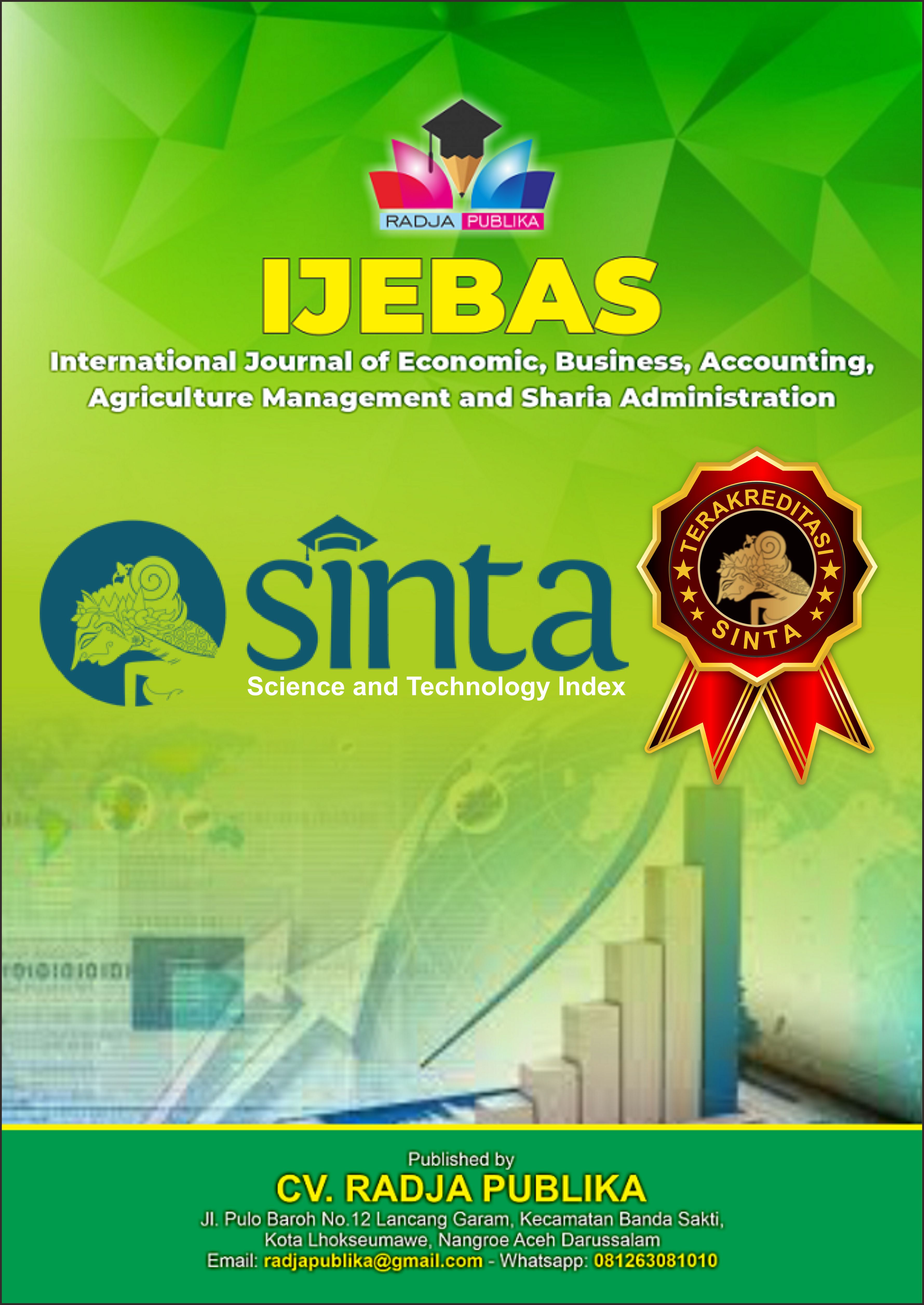DECENTRALIZATION TO ACHIEVE REGIONAL INDEPENDENCE WITH COMPETITIVE ADVANTAGE AS A MODERATION
Main Article Content
Agustina Br Surbakti
Lakharis Inuzula
Zulkarnaini
Kheriah
Yusmika Indah
Salman
This study aims to analyze the influence of decentralization, competitive advantage on the level of regional independence in the Lhokseumawe City government, and measure the magnitude of the interaction between decentralization and competitive advantage on the level of regional independence in the Lhokseumawe City government. Decentralization has aspects of strong and quality resource mechanisms, to management strategies including being superior in competing. Local governments must have the right method to be able to compete, so as to fulfill aspects of healthy and sustainable competitive advantage. Referring to competitive advantage, local governments must determine the right strategy, appropriate and guarantee local governments to appear "different" from other regions. Through this, the government will be able to guarantee the sustainability and welfare of the community in the long term. This study uses Moderated Regression Analysis (MRA) with data processing using SEM-PLS. Determination of the sample using Purposive Sampling of all apparatuses in the Lhokseumawe City Regional Work Unit with the number of selected samples being 122 apparatuses. The results of the study found that decentralization and competitive advantage had a significant effect on the level of regional independence. While competitive advantage has succeeded in becoming a quasi-moderation function, which means that the better the decentralization supported by competitive advantage, the higher the level of regional independence. Thus, the value of Regional Original Income (PAD) will be higher as an indicator of the expected level of independence.
Abdul Halim. (2004). Bunga Rampai: Manajemen Keuangan Daerah. Edisi Revisi. Penerbit UPP AMP YKPN. Yogyakarta.
Asep Deni, Fatkhur Rohman Albanjari, Agus Nurofik, H.M. Anwar, Asri Ady Bakri, Wayan Suryathi, Ramli S., Herie Saksono, Heri Faisal Harahap, dan Mochammmad Isa Anshori. (2024). Metodologi Penelitian Bisnis. Penerbit: Yayasan Cendikia Mulia Mandiri. Batam.
Bagus, I., Purbadharmaja, P., Ananda, C. F., & Santoso, D. B. (2019). The implications of fi scal decentralization and budget governance on economic capacity and community welfare. 21(2), 227–249. https://doi.org/10.1108/FS-05-2018-0052.
Cho, I. G. (2018). Fiscal decentralization in Korea. 7(3), 279–290. https://doi.org/10.1108/AEDS-11-2017-0113. Asian Education and Development Studies Vol. 7 No. 3, 2018 pp. 279-290 © Emerald Publishing Limited 2046-3162. DOI 10.1108/AEDS-11-2017-0113.
Dixit, S., Singh, Shiwangi., Dhir, Sanjay., and Dhir, Swati. (2021). Antecedents of strategic thinking and its impact on competitive advantage. 13(4), 437–458. https://doi.org/10.1108/JIBR-08-2020-0262. Journal of Indian Business Research. Vol. 13 No. 4, 2021. pp. 437-458. © Emerald Publishing Limited. 1755-4195. DOI 10.1108/JIBR-08-2020-0262.
Gujarati, Damodar N. (2003). Basic Econometrics. 4th Edition, New York, McGraw Hill. New York.
Hair, Joseph Franklin, M. Hult, G. Thomas, M. Ringle, Christian, and Sarstedt, Marko. (2022). A Primer on Partial Least Squares Structural Equation Modeling (PLS-SEM). Copyright ©2022 by SAGE Publications, Inc.
Imam Ghozali. (2002). Aplikasi Analisis Multivariate Dengan Program SPSS. Badan Penerbit Universitas Diponegoro. Semarang.
Koo, Jun & Kim, Byong Jun. (2018). Two Faces of Decentralization in South Korea. Asian Education and Development Studies Vol. 7 No. 3, 2018 pp. 291-302 © Emerald Publishing Limited 2046-3162 DOI 10.1108/AEDS-11-2017-0115.
Le, Phong Ba & Lei, Hui. (2018). The effects of innovation speed and quality on differentiation and low-cost competitive advantage: The case of Chinese firms. Chinese Management Studies Vol. 12 No. 2, 2018 pp. 305-322 © Emerald Publishing Limited 1750-614X. DOI 10.1108/CMS-10-2016-0195
Muzakar Isa. (2016). Model Penguatan Kelembagaan Industri Kreatif Kuliner Sebagai Upaya Pengembangan Ekonomi Daerah. Prosiding Seminar Nasional Ekonomi dan Bisnis dan Call For Paper FEB UMSIDA 2016.
Morozov, Boris. (2016). Decentralization: Operationalization And Measurement Model. International Journal Of Organization Theory And Behavior. 19(3), 275–307.
Mudrajad Kuncoro. (2003). Metode Riset untuk Bisnis dan Ekonomi. Erlangga-Jakarta.
Nur Indriantoro dan Bambang Supomo. (2002). Metodologi Penelitian Bisnis untuk Manajemen dan Akuntansi. BPFE-UGM. Yogyakarta.
Porter, Michael E. (2008). Competitive Advantage (Keunggulan Bersaing): Menciptakan dan Mempertahankan Kinerja Unggul. Kharisma Publishing. Tangerang.
Reiza Miftah Wirakusuma. (2014). Analisis Kegiatan Ekonomi Kreatif Di Kawasan Wisata Bahari Pulau Tidung Kepulauan Seribu. Jurnal Manajemen Resort & Leisure.Volume 11 Nomor 1, April 2014.
Sekaran, Uma. (2003). Research Methods for Business, A Skill building Approach. Fourth Edition.Wiley. Pp. 87.
Sigalas, C. (2013). Competitive advantage : the known unknown concept. https://doi.org/10.1108/MD-05-2015-0185. Management Decision. Vol. 53 No. 9, 2015. pp. 2004-2016. ©Emerald Group Publishing Limited. 0025-1747. DOI 10.1108/MD-05-2015-0185.
Sugiyono. (2011). Metode Penelitian Kuantitatif, Kualitatif dan R&D. Alfabeta: Bandung.
Syafrida Hasni Sahir. (2021). Metodologi Penelitian. Penerbit: KBM Indonesia. Yogyakarta.
Tegar Arief. (2023). Kemandirian Fiskal daerah Masih Rendah. https://datacenter.ortax.org/ortax/berita/show/18595. Diakses tanggal 25 Februari 2024.
Yang, S., & Li, Z. (2020). Fiscal decentralization , preference for government innovation and city innovation. 14(2), 391–409. https://doi.org/10.1108/CMS-12- 2018-0778
Zulkarnaini, Halimatussa’diyah, Kheriah dan Anhar Firdaus. (2020). Penerapan Ekonomi Kreatif Berbasis Syariah Melalui Good Governance Untuk Mencapai Tingkat Kemandirian Daerah. Prosiding Seminar Nasional Politeknik Negeri Lhokseumawe. Vol.4 No.1 November 2020 | ISSN: 2598-3954.



























